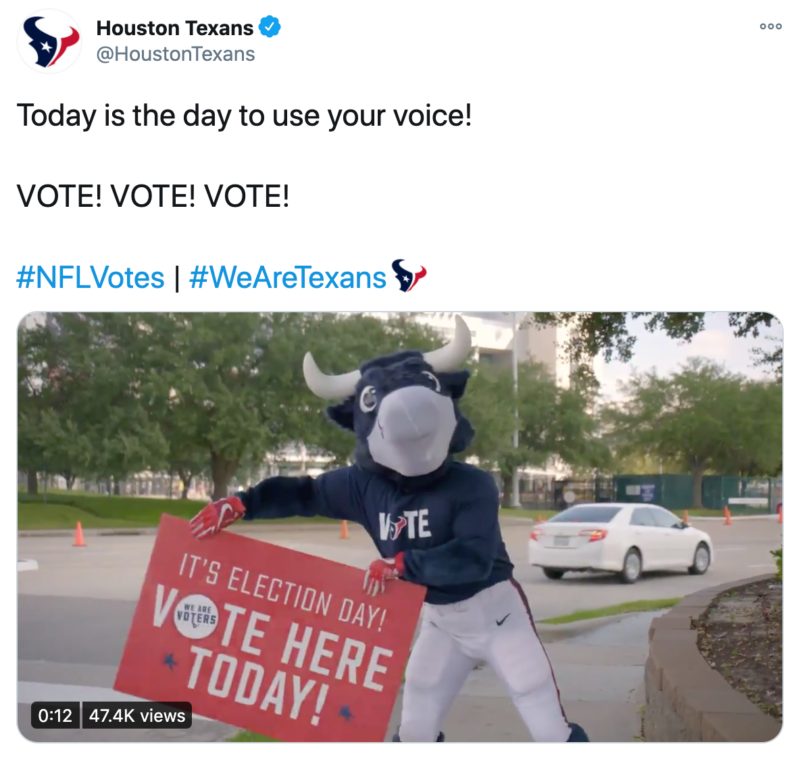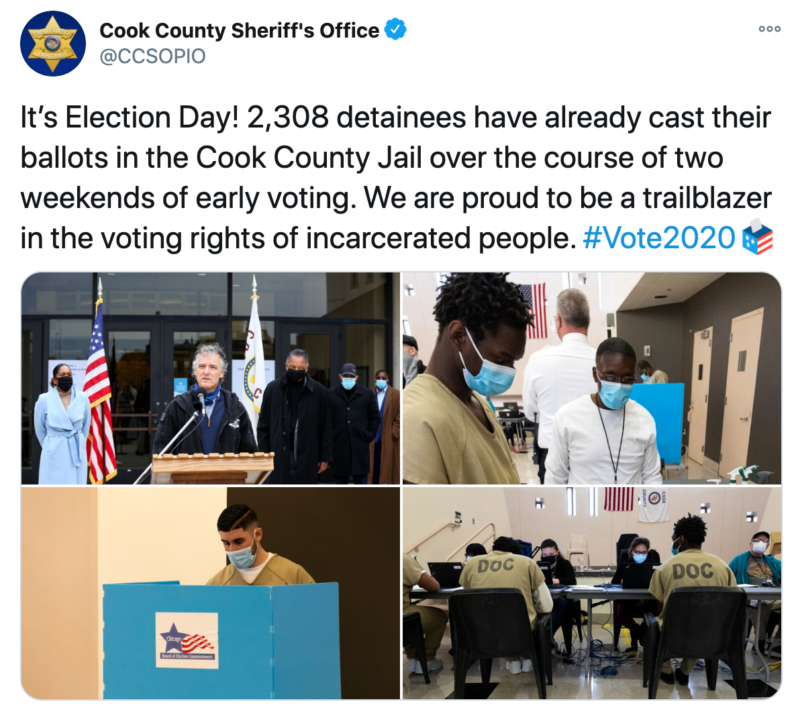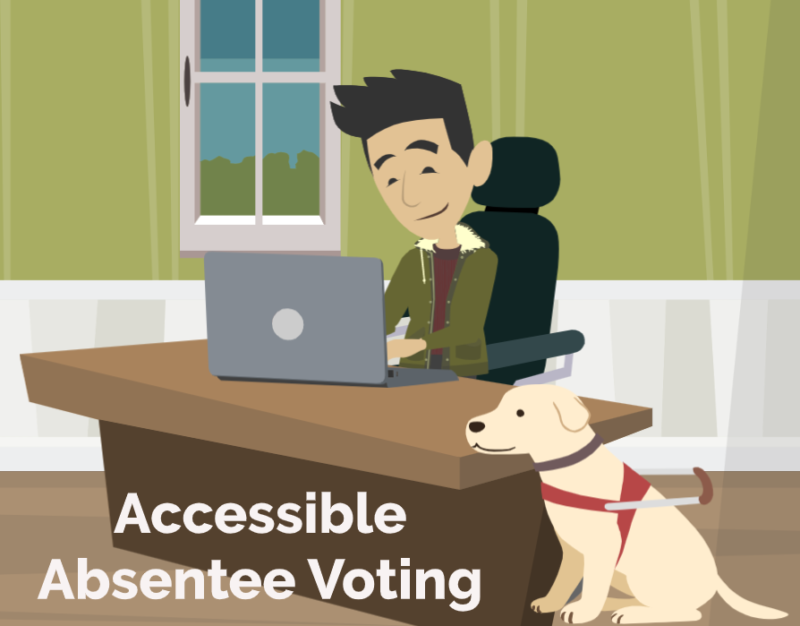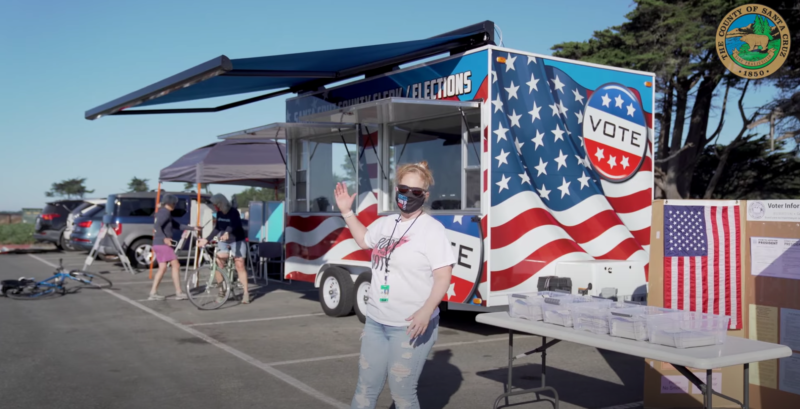20 Ways Election Officials Increased Accessibility During the November Election
This round-up was featured in our ELECTricity newsletter in November 2020. (Note: This is a round-up of what election offices across the country are doing; CTCL does not have official policy recommendations). Sign up to receive more success stories from election offices across the country.
This year has presented election officials with unprecedented challenges, including record levels of political division, increasing racial tension, natural disasters, and of course, the COVID-19 pandemic. Despite these obstacles, the presidential election ran smoothly and a record number of Americans turned out to vote, due in large part to election officials’ tireless efforts. Election offices across the country not only reinvented their procedures so that voters could remain safe, but they also went above and beyond to ensure accessibility for voters with disabilities and historically disenfranchised communities.
While many of these initiatives were implemented as emergency responses to the COVID-19 pandemic, election officials are suggesting that these changes become permanent features of future elections. That way, every voter, regardless of age, background, or ability, can easily participate in the electoral process.
If you’re looking for other resources for increasing accessibility within your election office, we recommend watching two of our free online trainings: Ensuring Access, Equity, and Inclusion and Accessible Communication for Election Offices.
Categories:
- Making Voting Safe During a Pandemic
- Engaging Historically Disenfranchised Populations
- Supporting Voters with Disabilities
- Improving Access for Displaced Voters
Making Voting Safe During a Pandemic
1. Designating Polling Locations for Voters with COVID-19. In order to keep voters who tested positive for COVID-19 separated from others, election officials in states like Tennessee directed infected voters to specified locations where they could vote safely. Both Hamilton County and Knox County had teams of poll workers dressed in full protective equipment to guide voters through the process, handing out single-use pens and folders so that anything the voters touched would not be handed back to election officials.
2. Partnering with Sports Arenas. This year, dozens of sports facilities were repurposed as polling stations, since their massive size could accommodate thousands of voters while still leaving plenty of room for social distancing. Several of these locations, such as the D.C. Mystics Arena, directly benefited underserved communities who experienced long lines during the primary election. Several election offices also forged thoughtful partnerships with sports teams to encourage people to turn out to vote. The Harris County Clerk’s Office teamed up with the Houston Texans football team to launch the “We Are Voters” initiative. And Indiana’s Secretary of State partnered with Pacers Sports & Entertainment for a “Beat the Buzzer” campaign, complete with public service announcements in both Spanish and Burmese.

3. Controlling Long Lines. In Utah County, Utah, election officials came up with a creative solution to controlling long lines: texting people when it’s time for them to vote. After entering one of Utah County’s eight polling locations, voters received a QR code or phone number confirmation. Then, they waited in their cars until it was their turn to vote. Implementing such processes to control long lines at polling places not only keeps voters safe by making it easier to social distance, but also keeps them out of the cold weather, which could deter them from voting.
4. Hand Delivering Ballots. Some voters who were too sick to leave home, or who were quarantining, could still exercise their right to vote without leaving the house. Some jurisdictions, such as Boone County, Missouri, hand delivered ballots to their voters to ensure that they would not be left out of the democratic process.
5. Reaching Voters in Nursing Homes. In order to include populations that are at a higher risk for COVID-19, jurisdictions across the country have made an effort to safely assist residents in nursing homes and similar facilities with completing mail-in ballots. In Durham County, North Carolina, the Board of Elections appointed a multi partisan assistance team to help residents vote. In New York, the Monroe County Board of Elections has a team member who was dedicated to reaching out to as many nursing homes as possible to drop off and pick up completed ballots. Election officials in Maricopa County, Arizona used videoconferencing for the first time to help voters in nursing homes cast their ballots. This innovative approach allowed residents to protect themselves against COVID-19 while still participating in the election.
6. Promoting Curbside Voting. Many states, like Mississippi and North Carolina, expanded curbside voting so that voters could cast their ballots from their vehicles. This provided a safe option for voters who tested positive for COVID-19, were experiencing symptoms, or were quarantining. Curbside voting is also a wonderful option for wheelchair users and other voters who have limited mobility. In several jurisdictions in Missouri, including Buchanan County and Cole County, election offices hosted curbside absentee voting events to alleviate pressure on Election Day. And Davis County, Utah made a curbside voting location available for voters who had not received their ballot in the mail or for those with a disability.
7. Expanding Vote-By-Mail Options. In an effort to stop the spread of COVID-19, several states made mail-in voting easier than ever before. Millions of voters had the option to bypass polling places and vote from the comfort and safety of their homes. In previous years in states including Kentucky, Delaware, and Massachusetts, voters needed an excuse to vote by mail. But for the November Election, any voter in these states could request an absentee ballot. Other states, like West Virginia and Arkansas, did not remove their excuse requirement, but made it clear that concern over the coronavirus was a valid excuse to vote by mail. And in California, Vermont, and D.C., every registered voter received a mail-in ballot for the first time.
Engaging Historically Disenfranchised Populations
8. Registering Voters Serving Out Felony Sentences. Imprisonment rates disproportionately impact Black and Hispanic Americans. That’s why for election officials, registering voters serving out felony sentences is an issue of social and racial justice. This summer, D.C. became the first jurisdiction in the U.S. to restore voting rights for people serving time for felony convictions. In response, the D.C. Board of Elections worked with the Federal Bureau of Prisons to send voter registration forms to 2,400 residents serving out felony sentences so that they could vote via absentee ballots in the November election.
9. Offering In-Person Early Voting for Incarcerated Individuals. The nation’s second largest prison, Cook County Jail in Illinois, served as a polling location this year. This marked the first time in U.S. history that a prison hosted in-person early voting for a general election. It saw a 40% voter turnout rate, with over 2,000 incarcerated individuals casting ballots.

10. Educating Ex-Felons and Incarcerated Individuals. Lack of information often prohibits ex-felons from participating in elections. In order to ameliorate this situation, this fall, the Georgia Secretary of State updated its website to include information about when ex-felons can legally exercise their voting rights, a small positive step toward providing clarity to those who were formerly incarcerated. Similarly, McLean County, Illinois has included a factsheet on their website about voting with a criminal record. Election officials there have worked with the Sheriff’s department for more than a decade, providing information and voter registration forms to incarcerated individuals.
11. Supporting Voters who Speak English as a Second Language. In order to serve their diverse constituents, the Michigan Secretary of State’s Office supplemented its website with voter information in Arabic, Burmese, Hindi, Korean, Mandarin, Spanish, Tagalog, and Urdu. Eventually, they plan to include voter registration and absentee ballot request forms translated into each of these languages, plus Bengali and Thai. In Dekalb County, Georgia, election officials offered information, including sample ballots and FAQs, in Spanish and Korean on their website. In doing so, they went above and beyond the Voting Rights Act requirements and became the first county in the state to offer an officially translated ballot in an Asian language.
12. Offering Late-Night Voting Options. For those who work 12-hour shifts or multiple jobs, voting between 7 a.m. and 7 p.m. when polls are typically open can be a serious challenge. Hoping to offer community members additional options and increase turnout, eight polling places in Harris County, Texas remained open all night. Over 10,000 night owls cast their ballots thanks to the new initiative.
13. Educating Native Americans to Reverse Historic Suppression. Native Americans have historically faced obstacles and voter suppression when it comes to voting. But Colorado Secretary of State Jena Griswold is hoping to engage Native American communities in a meaningful way. In October, Griswold hired Raymond Baker, a member of the Southern Ute Indian Tribe, as Tribal Registration and Voting Education Coordinator. Griswold believes that this newly created non-partisan position will help ensure that people living on tribal lands will have access to the information they need about exercising their right to vote.
Supporting Voters with Disabilities
14. Expanding ASL Resources. Jurisdictions throughout the country stepped up to assist the deaf community during the election process. Lubbock County, Texas became the first county in the state to provide an American Sign Language (ASL) interpreter at the polls. And Minnesota’s Secretary of State forged a partnership with the Minnesota Commission of the Deaf, Deafblind, and Hard of Hearing to produce video “fact sheets” in ASL which offer crucial information about how to cast a ballot. Together, they also set up a voter information hotline in ASL to let voters know how and where to vote, and how to track their ballots.
15. Offering Private and Independent Voting Options. This fall, thousands of citizens who are blind or visually impaired were offered the option to vote privately and independently for the first time. Kentucky, Massachusetts, New Jersey, Virginia and five counties in Florida implemented accessible mail-in voting procedures, which allow voters to electronically access a ballot that is compatible with screen reader technology. Voters could mark their ballots themselves, from the comfort of their homes without any assistance, keeping the process completely private. Earlier this year, states including Michigan, Nevada, and Pennsylvania adopted similar processes.
16. Developing Online Voting Portals. The North Carolina State Board of Elections has also taken steps to make it easier for individuals with disabilities to vote. Thanks to a new accessible online voting portal, voters could request, receive, and return their ballots without having to print out or mail anything. Maine’s Secretary of State also created a similar process. Voters could download their ballots as an accessible PDF file, fill it out digitally, and send it back via email. These online initiatives benefit voters with vision impairment or blindness, physical dexterity limitations, learning disabilities, and cognitive impairment.

17. Partnering with Disability Rights Groups. In order to ensure that voters with disabilities have a positive voting experience, the Iowa Secretary of State partnered with Disability Rights Iowa to equip each polling place in the state with a Voting Accessibility Quick Check booklet. Precinct officials used this new material to recognize and address accessibility issues on Election Day.
Improving Access Among Displaced Voters
18. Providing Critical Information on Election Websites. For voters affected by wildfires, figuring out how to vote in the November election was undoubtedly a source of confusion and anxiety. That’s why the Washington and Oregon Secretaries of State updated their websites with clear information to assure their citizens that they could still vote safely. The California Secretary of State also created a fact sheet for displaced voters which they shared on social media to get the word out.
19. Implementing Mobile Voter Sites. Election officials understood that access to voting this year would be a significant challenge for those who recently lost their homes to wildfire. That’s why two counties in California developed mobile voting sites to bring the ballot box out into their communities. Los Angeles County’s Mobile Voting program set up stations in parking lots and plazas, while Santa Cruz County’s VoteMobile truck drove around the community, capturing the public’s attention with its brightly painted exterior. Aside from assisting voters displaced by natural disasters, these innovative voting options also benefit people experiencing homelessness, seniors, geographically isolated voters, and those with disabilities.

20. Supporting People Experiencing Homelessness. The pandemic and ensuing economic crisis has exacerbated the issue of homelessness in the U.S. In an effort to include people experiencing homelessness in the electoral process, Michigan’s Secretary of State partnered with the nonprofit, Michigan Coalition Against Homelessness, to promote voter education and registration. The Secretary of State’s website also features a section about voting rights for housing insecure individuals which they shared on social media.
What else are you doing?
What is your office doing to increase accessibility? What have you seen other offices do? We’d love to hear from you! Let us know by emailing [email protected].